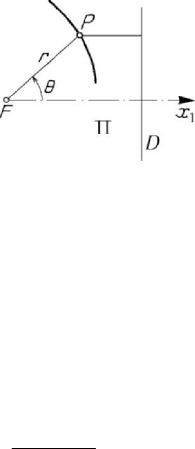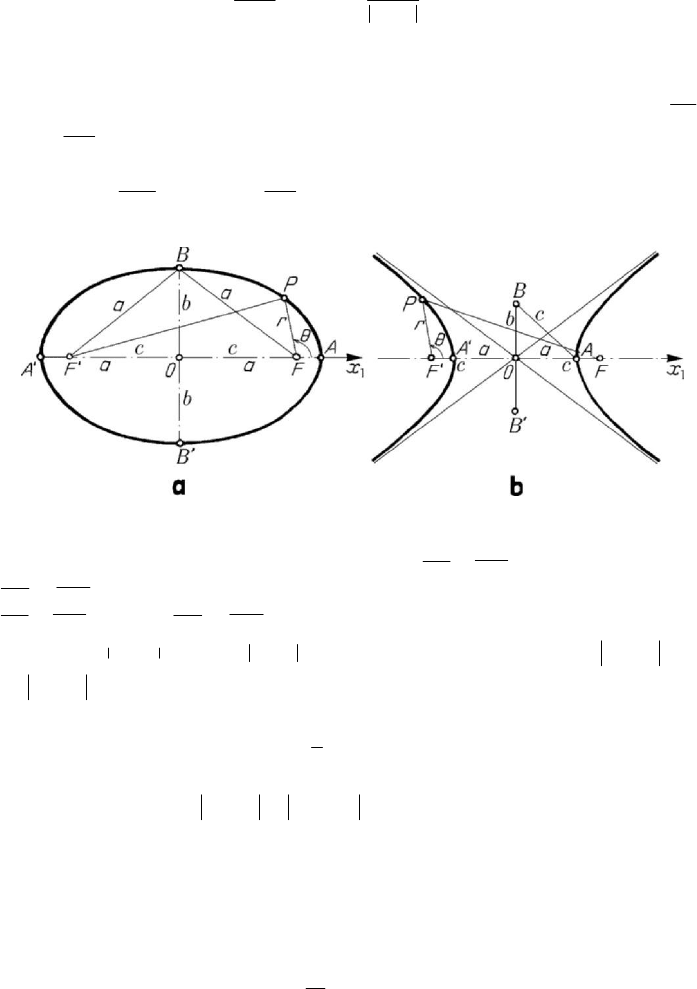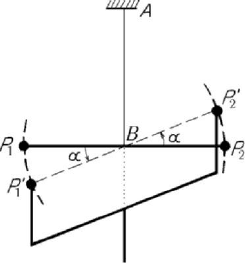Teodorescu P.P. Mechanical Systems, Classical Models Volume I: Particle Mechanics
Подождите немного. Документ загружается.


MECHANICAL SYSTEMS, CLASSICAL MODELS
542
In the particular case of the equation (8.2.93), the approximation of second order is
given by
22
3
11
3
1
222
00
d
cos cos
d
x
a
xa
ω
ττ
τωω
+= −
2
22
1
22 2
00 0
3
cos cos 3
4
4
aa
a
ω
ττ
ωω ω
⎡
⎛⎞ ⎤
=− −
⎜⎟
⎢
⎥
⎣
⎝⎠ ⎦
,
wherefrom, taking into account the initial conditions, it results
2
32
1
1
222
000
3
() (cos3 cos) sin
42
32
aa
xa
ω
π
τττ τ
ωωω
⎛⎞
=−+−
⎜⎟
⎝⎠
.
Equating to zero the secular term, we obtain
22
1
3/4aω = , so that, in the second
approximation, we have
22
22
00
() 1 cos cos3
32 32
aa
xt a t t
εωεω
ωω
⎡⎛ ⎞ ⎤
=− +
⎜⎟
⎢⎥
⎣⎝ ⎠ ⎦
,
(8.2.102)
with the pulsation (8.2.94); we find again the period (8.2.94'). The dependence of the
pulsation on the amplitude is thus put into evidence.
The perturbations method may be applied also in case of non-autonomous systems,
the motion of which is modelled by differential equations of the form
2
0
(,;) 0xxfxxtωε++ = ,
(8.2.103)
where the function
f
is periodic with respect to t and has a known pulsation. By a
phase shifting of the periodic solution with respect to the perturbing force, we may
introduce the phase shift
2
0
12
...δδ εδ εδ=+ + +,
(8.2.104)
the computation procedure being, further, similar to that above.
Among the computation methods which may be applied, we mention also the
graphic methods (the isoclinic lines method, the delta method, the graphic methods for
non-autonomous systems etc.).
Chapter 9
NEWTONIAN THEORY OF UNIVERSAL
ATTRACTION
In the preceding chapter, we have considered the action of an elastic force of
attraction upon a particle, case in which, after Bertrand’s theorem, the orbit is a closed
curve. We will now study the action of forces of Newtonian attraction which, on the
basis of the same theorem, lead to analogous trajectories; we pay a particular attention
to those forces, because they are the most important ones of mechanical nature which
are exerted by a body upon another one. The mathematical modelling of the universal
forces of attraction corresponds to the classical model of mechanics (as it has been
conceived by Newton) and to its gorgeous verification by astronomical observations
(Kepler’s laws). The results thus obtained will be applied to the study of planets’
motions, to the problems of the artificial Earth satellites and of the interplanetary
vehicles, to the motion at the atomic level etc.
1. Newtonian model of universal attraction
After considerations concerning the classical model of universal attraction, a study of
the Newtonian potential is made; the modelling as particles of celestial bodies is just
justified.
1.1 Principle of universal attraction
Starting from Kepler’s laws, considered as laws of experimental nature (obtained by
astronomical observations), we deduce – in what follows – the law of Newtonian
attraction; we can make thus the connection with the gravitational fields.
1.1.1 Law of Newtonian attraction
Starting from the astronomical observations of his predecessors (especially those of
the Dane Tycho Brahe at his observatory on the Ven isle, between Denmark and
Sweden, and then as astronomer at the Imperial Court in Prague), Johann Kepler
enounced three laws which are modelling the motion of planets in the solar system.
Thus, the planets (modelled as particles) describe ellipses with respect to the Sun
(considered to be situated at one of the foci), the motion being governed by the law of
areas; the ratio of the cube of the semi-major axis to the square of the revolution time
T
is the same for all planets. However, Kepler tried to obtain a synthesis of these laws,
without obtaining a final result (in an Aristotelian conception, he thought that the force
543

MECHANICAL SYSTEMS, CLASSICAL MODELS
544
is directed along the tangent to the trajectory). But Newton, using Kepler’s laws,
succeeded to set up the mathematical model of classical mechanics, deducing the
expression of the force of universal attraction too; these results (taking into account the
modality to obtain them, they may be considered as deriving from Kepler’s laws, the
latter ones being a mathematical model of mechanics) represent, in fact, the most
important contributions of Newton to the development of mechanics. In
contradistinction to Kepler’s model, the Newtonian one has a general character and may
be applied to all bodies of the real world.
Figure 9.1. Conics.
To can express mathematically Kepler’s laws, it is useful to introduce the equation of
an ellipse and – in general – the equation of a conic in polar co-ordinates. To do this,
we remember that a conic represents the locus of the points
P of a plane Π for which
the ratio of the distances to a fixed point
P Π
∈
(called focus) and to a fixed straight
line
D Π∈ (called directrix), respectively, is constant (the respective constant,
denoted by
e , is called eccentricity) (Fig.9.1); if 01e
≤
≤ , then the conic is an ellipse
(
0e = corresponds to a circle), if 1e
=
, then it is a parabola, while if 1e > , then it is
a hyperbola. The equation of the conic with respect to the focus
F is written in the
form
1cos
p
r
e θ
=
+
,
(9.1.1)
where
0p > is the conic parameter (the semilatus rectum).
Observing that the Sun is at the focus
F , while the planet of mass m is at the point
P , the forces which represent the action of one of the bodies upon the other one are
internal forces in the system formed by the two bodies, modelled as particles. Assuming
that the point
F is fixed (we consider the motion of the planet relative to this point),
the force
F which acts upon the planet is a central force. Because the trajectory of the
planet is an ellipse, it results that the point
F represents a position of stable
equilibrium, the force
F being directed towards this point. The law of areas leads also
to the conclusion that the force
F is a central one. Replacing r given by (9.1.1) in
Binet’s formula (8.1.8), we get
22
/FmCpr=− ; hence, the magnitude F of the force
is inverse-square to the distance between the Sun and the planet. As we have seen in
Chap. 5, Subsec. 1.1.4,
AΩ
=
, where the area A is the measure of the surface
described by the radius vector; if that radius describes the whole ellipse, then, by
integrating on the interval
[
]
0,T , where T is the revolution time of the planet (the
time in which the whole ellipse is described), we obtain
2 ab CTπ
=
, where (6.1.57'')
has been taken into account (the area of the ellipse of semiaxes
a and b is abπ ).

Newtonian theory of universal attraction
545
From (9.1.1), one obtains (for
0θ
=
and θπ
=
, respectively)
min
1
p
r
e
=
+
,
max
1
p
r
e
=
−
,
(9.1.1')
corresponding to the apsidal points, called pericentres and apocentres, respectively. It
results
max
min
2rr a±=, as we have to do with an ellipse or a hyperbola, respectively,
0a > being the semi-major axis; in the first case, we have 0r > , so that
min
rFA= ,
max
rFA
′
= (Fig.9.2,a), while in the second case we have
0r ≷
as it corresponds to
the branch of the hyperbola the focus of which is taken as origin or to the other branch,
so that
min
rFA
′′
=
and
max
rFA
′
= (Fig.9.2,b). We also notice that
Figure 9.2. Conics. Ellipse (a). Hyperbola (b).
the ellipse is the locus of the points for which
2constPF PF a
′
+
==
(so that
BF BF a
′
==), while the hyperbola is the locus of the points for which
2PF PF a
′
−=. If 0FO F O c
′
==> is the focal distance to the centre, it results
/(1 )peac+=−, /1peac
−
=+, wherefrom
2
/1pe e c−=
,
2
/1pea−=; for both conics we get thus the eccentricity
c
e
a
=
(9.1.2)
and the parameter
222
1/pa e a c a=−=− . Observing that
222
acb
=
± ,
(9.1.2')
where
0b > is the semi-minor axis (the semi-major axis of the conjugate hyperbola, in
case of a hyperbola), we may write
2
b
p
a
=
.
(9.1.2'')

MECHANICAL SYSTEMS, CLASSICAL MODELS
546
In this case,
22222232
/4 / 4 /Cp abpT aTππ==, so that
3
2
22
4
ma
F
rT
π=− ;
(9.1.3)
taking into account the third law of Kepler (see Subsec. 2.1.4), there results
2
m
F
r
μ=− ,
(9.1.3')
where
() 0Mμμ
=
> , M being the Sun mass ( μ depends only on the Sun, because
it is independent of the particular planet considered). Newton assumed that this
independence is linear, so that
()MfMμ
=
, the force exerted by the Sun upon the
planet of mass
m , situated at the distance r , being thus given by
2
mM
Ff
r
=−
(9.1.3'')
and corresponding to the formula (1.1.84'). Indeed, if the action of the Sun upon a
planet
j
P of mass
j
m is a force of modulus
2
/
j
mrμ , ()Mμμ
=
, and if the planet
j
P acts upon the Sun with a force of modulus
2
/
j
Mrμ
, ()
j
jj
mμμ
=
, then,
corresponding to the principle of action and reaction, we may write
22
//
jj
mr Mrμμ= , 1,2,...,j = wherefrom
11 22
/ / / ...Mm mμμ μ
=
==; the
common ratio is just the constant
0
f
>
of universal attraction, which leads to the
expression of the universal (Newtonian) law of attraction. This model of the force of
attraction of the bodies in Universe has been extended by Newton for all the bodies,
immaterial of the magnitudes of their masses, in the form (corresponding to the formula
(1.1.84))
12
2
mm
Ff
r
=−
,
(9.1.4)
where
1
m and
2
m are the masses of two bodies situated at the distance r one of the
other (the distance between their centres of mass, the bodies being modelled as
particles). As we have seen in Chap. 1, Subsec. 1.1.12, these forces are conservative.
One obtains thus the universal (Newtonian) law of attraction.
The coefficient
f
may be obtained experimentally in a particular case and is given,
in the CGS – system, by
8
6.6732 10
f
−
=⋅
22
1/ 3871 cm/g s
≅
⋅ . The first
determination in a laboratory has been made a century later by Cavendish, in 1798, with the
aid of a balance of torsion. The apparatus is formed by a thread
AB suspended at A
and supporting at the end
B a horizontal bar at the ends of which are two small spheres
1
P
and
2
P
(
12
BP BP= ) of masses
1
m and
2
m , respectively. If we put in the vicinity
of these spheres a fork with two spheres
1
P
′
and
2
P
′
of masses
11
mm
′
and

Newtonian theory of universal attraction
547
22
mm
′
, respectively (usually,
12
mm
=
and
12
mm
′
′
=
), then, due to the forces of
Newtonian attraction which arise, the sphere
1
P is attracted by the sphere
1
P
′
and the
sphere
2
P is attracted by the sphere
2
P
′
; thus, a circular motion of angle α takes place
(Fig.9.3). The thread
AB is subjected to torsion, wherefrom the denomination of the
apparatus. Because the angle
α is proportional to the couple formed by the Newtonian
forces of attraction applied upon the particles
1
P and
2
P , one can calculate the
coefficient
f
.
Figure 9.3. Balance of torsion.
Building up a mathematical model of universal attraction, in the frame of a classical
model of mechanics, Newton opened a large outlook to the development of science;
among others, this model is the basis of celestial mechanics, where the fundamental
problem is that of
n particles (e.g., The Sun, the Earth and the Moon – the problem of
the three bodies, modelled as particles). Starting from the Newtonian theory of
universal attraction, one could show, only by computation, that the Earth is an oblate
spheroid (it is oblate at the poles), one could discover, only by computation too, new
planets (thus, Leverrier discovered, in 1846, the planet Neptune, and – recently – a
tenth planet has been intuited), one could predict the trajectories of the interplanetary
vehicles (stating thus the basis of the theory of cosmic motions) etc.
In the following section we show that all celestial bodies, considered to be of quasi-
spherical form, may be modelled as particles situated at their centres of mass and
having a mass equal to that of the respective body.
1.1.2 Law of universal gravitation
We have seen in Chap. 1, Subsec. 1.1.12 that the gravity forces, due to the presence
of a gravitational field, may be considered as particular cases of forces of Newtonian
attraction (which, by extension, are called forces of universal gravitation too); one
obtains thus the law of universal gravitation. Hence, it results the remarkable relation
(1.1.85), which links the constant
f
to the mass
M
of the Earth, considered as a
sphere of radius
R , and to the gravity acceleration g .
The potential
/
f
mM R (m is the mass of a body situated at the distance H from
the Earth surface, along the local vertical) must be replaced by

MECHANICAL SYSTEMS, CLASSICAL MODELS
548
(
)
(
)
1
11
mM mM H mM H
ff f
RH R R R R
−
=+≅−
+
2
mM mM mM
f
fHf mgH
RR
R
=− ≅−,
where we took into account (1.1.85). This potential differs from that known (see
formula (1.1.83)) by the additive constant term
/
f
mM R . We notice that in case of the
potential
/( )
f
mM R H+ the zero level is at infinity, while in case of the potential
mgH− the zero level is at the Earth surface.
The motion of a particle in a gravitational field leads to the equation
g
i
mm=ag,
where, due to the equality between the inertial mass and the gravitational one (the
relation (1.1.24)), these ones disappear from computation. In case of a motion in an
electric field
E
, which acts upon the particle with the force
eE
, where e is the electric
charge, the equation of motion is of the form
i
me
=
aE; (9.1.5)
in this case, the inertial mass does no more disappear, being different from the electric
charge
e .
Let us consider the motion of the Moon around the Earth; a force of attraction of the
form (9.1.3), (9.1.3'), for which
23 2
4/aTμπ= , arises. A particle of mass equal to
unity at the Earth surface is attracted to that one by a force equal to
2
11/gRμ⋅=⋅ ,
being a constant which depends on the mass of the Earth of radius
R . We obtain thus
the relation
3
2
22
4
a
g
RT
π= ,
(9.1.6)
which allows to calculate the gravity acceleration. The trajectory of the Moon is quasi-
circular, with
60 384 000 kmaR≅≅ ; it results
23 2
460 /gRTπ≅ . Because
6370 kmR ≅ and 2 40 000 kmRπ ≅ , the time of revolution of the Moon being 27
days 7 hours 43 minutes
39 343 60 s=⋅, Newton has obtained
2
9.8 m/sg ≅ , in a
good concordance with the result previously obtained by Galileo. Taking into account
what was shown above, it results that the ratio of the acceleration
γ of a free fall of the
Moon on the Earth to the gravity acceleration
g is equal to the ratio
22
(/) 1/60Ra ≅
;
taking
2
9.81 m/sg = , we get
32
2.72 10 m/sγ
−
=⋅ , result which corresponds to that
obtained in the study of Moon’s trajectory. Thus, we get a brilliant confirmation for the
coincidence of the two forces (the gravitational attraction and the weight at the Earth
surface).
The relation (1.1.85) allows to determine the mass of the Earth in the form
2
/MgRf≅ ; observing that
3
4/3MRπμ= , where μ is the mean unit mass, it
results

Newtonian theory of universal attraction
549
3
4
g
f
R
μ
π
= .
(9.1.6')
We get thus
3
5.51 g/cmμ = . This density is much greater than that of the superior
spherical strata of the Earth; we may thus conclude that the density is much greater
towards the centre of the Earth.
As we have seen in Chap. 1, Subsec. 2.1.3, the mass can be taken as derived unit,
which is expressed by means of units of length and of time as basic units, so that the
universal constant
f
becomes equal to unity. We introduce thus the natural hour
(which is approx. equal to 3871 seconds of mean time); this is the unit of time which
must be adopted so that, for an arbitrary unit of length and a unit of mass corresponding
to a cube of di1stillated water at
4C° , equal to unity, to obtain 1
f
=
.
1.2 Theory of Newtonian potential
To justify the modelling of celestial bodies as particles, we introduce – in what
follows – the Newtonian potential and put into evidence some of its properties; we
consider especially the surface and the volume potentials of the homogeneous sphere,
as well as the potential of the spherical stratum. We give some results concerning the
potential of the terrestrial spheroid too.
1.2.1 Newtonian potential
Corresponding to the universal gravitation law, a particle
Q of position vector ξ
and mass
m acts upon a particle P of position vector r and mass equal to unity with a
force of attraction given by
2
vers grad grad
f
mfm
QP f U
R
R
=− = =
J
JJG
F , R
=
−r
ξ
,
(9.1.7)
where the potential (see the formula (1.1.84'))
m
U
R
=
(9.1.7')
has been introduced (we have neglected an additive constant); thus, the projection of
the force
F on a direction of unit vector n is given by grad /
f
UfUn
⋅
=∂ ∂n .
In case of several centres of attraction
j
Q of position vectors
j
ξ
and masses
j
m ,
1,2,...,jn= , we obtain (in conformity with the principle of the parallelogram of
forces)
grad
f
U=F ,
1
n
j
j
j
m
U
R
=
=
∑
,
j
j
R =−r
ξ
.
(9.1.8)
Let be, in general, a mechanical system
S of geometric support Ω , at a finite
distance; the potential of the force of attraction
F exerted by S on the particle P is
given by the Stieltjes integral

MECHANICAL SYSTEMS, CLASSICAL MODELS
550
d
()
m
U
R
Ω
=
∫
r , R
=
−r
ξ
,
(9.1.9)
where ()mm
=
ξ is a distribution. Introducing the unit mass (1.1.71), (1.1.71''), we
obtain the relation (9.1.8) for a discrete mechanical system of
n particles
j
Q of
position vectors
j
ξ and masses
j
m , 1,2,...,jn
=
, or
()
() d
V
UV
R
μ
=
∫∫∫
r
ξ
, R
=
−r
ξ
,
(9.1.8')
in case of a continuous mechanical system of unit mass
1
() ( )CV Sμ ∈+ξ
(S is the
frontier of the domain of volume
V and verifies conditions of Lyapunov type).
If the continuum is homogeneous, then it results
d
()
V
V
U
R
μ=
∫
∫∫
r , R
=
−r
ξ
.
(9.1.8'')
We obtain thus the general form of the Newtonian potential, that is the volume potential
given by the formula (A.2.86). In case of a two-dimensional mechanical system
S, we
replace the volume integral by a surface one (it results a simple stratum potential of the
form (A.2.87)), using a superficial unit mass; if the mechanical system is plane, then the
integral is a double one. As well, in case of a one-dimensional mechanical system
S we
replace the volume integral by a curvilinear one, introducing a linear unit mass.
One can put in evidence following properties:
i)
()U r is a continuous function in the whole space and vanishes at infinity.
ii)
The derivatives of first order of
()U r (hence, the vector field grad ( )U r too)
are continuous functions in the whole space and vanish at infinity; they are
calculated by differentiation under the integral sign.
iii)
The derivatives of second order of
()U r have jumps by crossing the surface
S
; in particular, (one can make the connection with the formula (A.2.85))
4 ( ) in the interior of ,
()
0 in the exterior of .
V
U
S
πμ−
⎧
⎪
Δ=
⎨
⎪
⎩
r
ξ
(9.1.10)
iv) The behaviour at infinity of the potential is given by
(
)
23
1
() vers
mm
U
r
rr
=+ ⋅ +rrρ
O .
(9.1.11)
For the first two properties we assume that
()μ
ξ
is a bounded and integrable on V
function, while for the property iii) we consider that
()μ
ξ
is a function differentiable
on
V , their derivatives being bounded and differentiable functions. The first three

Newtonian theory of universal attraction
551
properties may easily be proved for particles
P in the exterior of the system S. If the
particle
P belongs to the interior of the system S, then that one becomes a singular
point (
=r
ξ
), and we isolate it by a sphere containing it; the volume integral must be
calculated for the domain of volume
V
from which one subtracts the interior of that
sphere, while the surface integral (which appears by using a formula of Gauss-
Ostrogradskiĭ type) must be calculated for the sphere too. The integrands have no
singularities in this case, no matter how small is the radius of the sphere; then, this
radius is equated to zero.
Concerning the property iv), we denote
OQξ ==
J
JJG
ξ , (, )ϕ
=
) r ξ . From the
triangle
OPQ , it results (assuming that r is sufficiently great,
ξ
being bounded, we
may use a binomial expansion or a Maclaurin series)
(
)
22
11 1 1 1
2cos
f
Rrr
rr
PQ
ξ
ξξψ
== = =
−
+−
JJJG
r ξ
(
)
(
)
1/2
2
()
00
1111
12cos (0) (cos)
!
n
n
n
nn
fP
rrr rn rr
ξξ ξ
ψψ
−
∞∞
==
⎡⎤
=+ − = =
⎢⎥
⎣⎦
∑∑
,
where
(cos )
n
P ψ are Legendre’s polynomials; we have
()
1
(cos ) (0)
!
n
n
Pf
n
ψ = , (0) 1
f
=
, (0) cos
f
ψ
′
=
,
2
(0) 3cos 1
f
ψ
′′
=
−
,...
Replacing in (9.1.8'), we get
(
)
23
11 1
() ()d cos ()d
VV
UV V
r
rr
μξψμ=+ +
∫∫∫ ∫∫∫
r ξξO ,
so that
()U r tends to zero as 1/r at infinity; observing that
()d
V
mVμ=
∫∫∫
ξ ,
1
()d
V
OC V
m
μ==
∫∫∫
J
JJG
ρξξ,
where
C is the centre of mass of the system S, we obtain the formula (9.1.11).
If, in particular, we choose the origin at the point
C , then we may write
(
)
3
1
() ()
m
UUr
r
r
==+
r O .
(9.1.12)
We may thus state that one obtains a sufficient good approximation by replacing the
mechanical system
S of attraction by its centre of mass C , at which we assume to be
concentrated the whole mass
m of the system (especially if the distance from the centre
of attraction
C to the particle P is sufficiently great). We show in the next subsection
that this result is rigorous if the mechanical system
S is with spherical symmetry.
